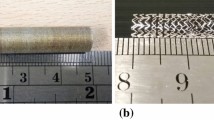Abstract
The mechanical properties of the stent are of key importance to the mechanical integrity and performance reliability of stent-plaque-artery system, and an ideal stent should have good bending compliance, axial deformation stability, hoop strength and stiffness, larger radial expandable ability, etc. In this paper, innovative chiral stent designs with auxetic properties are proposed, and amplified stent sample is fabricated with SLS additive manufacturing technique. Firstly, through combining micro-CT tomography and image-based finite element analysis, the mechanical properties of as fabricated SLS stent are explored; Secondly, two series of stent samples are fabricated with SLS additive manufacturing techniques, and in-situ compression experiments are performed for studying the deformation mechanisms and auxetic mechanical behaviors of stents. Finally, effects of geometrical parameters on the tensile mechanical performance of these stents are studied with finite element analysis. The proposed chiral stent exhibits auxetic behaviors, and can be tailored through adjusting the unit cell design parameters, such as: struct numbers along circumferential directions, ligament lengths, and node radius.













Similar content being viewed by others
References
Sanami M, Ravirala N, Alderson K, Alderson A (2014) Auxetic materials for sports applications. Procedia Engineering 72:453–458
Ren X, Das R, Tran P, Ngo TD, Xie YM (2018) Auxetic metamaterials and structures: a review. Smart Mater Struct 27:023001
Rafsanjani A, Pasini D (2016) Bistable auxetic mechanical metamaterials inspired by ancient geometric motifs. Extreme Mech. Lett 9:291–296
Álvarez Elipe JC, Díaz Lantada A (2012) Comparative study of auxetic geometries by means of computer-aided design and engineering. Smart Mater Struct 21:105004
Lakes RS (2017) Negative-Poisson's-ratio materials: Auxetic solids. Annu Rev Mater Res 47:63–81
Novak N, Vesenjak M, Ren Z (2016) Auxetic cellular materials - a review. Strojniški vestnik – J Mech Eng 62:485–493
Prall D, Lakes RS (1997) Properties of a chiral honeycomb with a poisson's ratio of −1. Int J Mech Sci 39:305–314
Alderson A, Alderson KL, Attard D, Evans KE, Gatt R, Grima JN, Miller W, Ravirala N, Smith CW, Zied K (2010) Elastic constants of 3-, 4- and 6-connected chiral and anti-chiral honeycombs subject to uniaxial in-plane loading. Comp Sci Tech 70:1042–1048
Wu W, Tao Y, Xia Y, Chen J, Lei H, Sun L, Fang D (2017) Mechanical properties of hierarchical anti-tetrachiral metastructures. Extreme Mech Lett 16:18–32
Wu W, Song X, Liang J, Xia R, Qian G, Fang D (2018) Mechanical properties of anti-tetrachiral auxetic stents. Comp Struct 185:381–392
Xia R, Song X, Sun L, Wu W, Li C, Cheng T, Qian G (2018) Mechanical properties of 3D isotropic anti-Tetrachiral Metastructure. Phys Status Solidi B 255:1700343
Li H, Ma Y, Wen W, Wu W, Lei H, Fang D (2017) In plane mechanical properties of Tetrachiral and Antitetrachiral hybrid Metastructures. J Appl Mech T-ASME 84:081006–081006–081012
Wu W, Geng L, Niu Y, Qi D, Cui X, Fang D (2018) Compression twist deformation of novel tetrachiral architected cylindrical tube inspired by towel gourd tendrils. Extreme Mech. Lett 20:104–111
Wu W, Qi D, Liao H, Qian G, Geng L, Niu Y, Liang J (2018) Deformation mechanism of innovative 3D chiral metamaterials. Sci Rep 8:12575
Liu XN, Huang GL, Hu GK (2012) Chiral effect in plane isotropic micropolar elasticity and its application to chiral lattices. J. Mech. Phys. Solids 60:1907–1921
Chen Y, Liu XN, Hu GK, Sun QP, Zheng QS (2014) Micropolar continuum modelling of bi-dimensional tetrachiral lattices. Proc Math Phys Eng Sci 470:20130734
Spadoni A, Ruzzene M (2012) Elasto-static micropolar behavior of a chiral auxetic lattice. J Mech Phys Solids 60:156–171
Wu W, Wang W-Q, Yang D-Z, Qi M (2007) Stent expansion in curved vessel and their interactions: a finite element analysis. J Biomech 40:2580–2585
García A, Peña E, Martínez MA (2012) Influence of geometrical parameters on radial force during self-expanding stent deployment. Application for a variable radial stiffness stent. J Mech Behav Biomed 10:166–175
Tan TW, Douglas GR, Bond T, Phani AS (2011) Compliance and longitudinal strain of cardiovascular stents: influence of cell geometry. Journal of Medical T- ASME 5:041002–041002–041006
Migliavacca F, Petrini L Fau - Massarotti P, Massarotti P Fau - Schievano S, Schievano S Fau - Auricchio F, Auricchio F Fau - Dubini G, Dubini G (2004) Stainless and shape memory alloy coronary stents: a computational study on the interaction with the vascular wall. Biomechan Model Mechanobiol 2:205–217
Praveen Kumar G, Jafary-Zadeh M, Cui F (2016) Deployment of a bulk metallic glass-based self-expandable stent in a patient-specific descending aorta. ACS Biomater Sci Eng 2:1951–1958
Migliavacca F, Petrini L, Colombo M, Auricchio F, Pietrabissa R (2002) Mechanical behavior of coronary stents investigated through the finite element method. J Biomech 35:803–811
Bhullar SK, Mawanane HAT, Alderson A, Alderson K, Martin BGJ (2013) Influence of negative Poisson’s ratio on stent applications. Adv Mater 2(3):42–47
Acknowledgments
This research is supported by the National Natural Science Foundation of China (Grant No. 11702023; No. 11632010),sponsored by the Opening fund of State Key Laboratory of Nonlinear Mechanics under Project No. LNM201804.
Author information
Authors and Affiliations
Corresponding authors
Additional information
Publisher’s Note
Springer Nature remains neutral with regard to jurisdictional claims in published maps and institutional affiliations.
Rights and permissions
About this article
Cite this article
Geng, L., Ruan, X., Wu, W. et al. Mechanical Properties of Selective Laser Sintering (SLS) Additive Manufactured Chiral Auxetic Cylindrical Stent. Exp Mech 59, 913–925 (2019). https://doi.org/10.1007/s11340-019-00489-0
Received:
Accepted:
Published:
Issue Date:
DOI: https://doi.org/10.1007/s11340-019-00489-0




